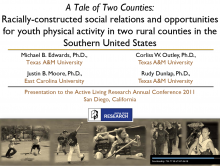We are pleased to announce an exciting new alliance between Active Living Research and GP RED to co-host and coordinate...
A Tale of Two Counties: Racially-Constructed Social Relations and Opportunities for Youth Physical Activity in Two Rural

Presentation at the 2011 Active Living Research Annual Conference
Background:
Youth living in rural areas of the South have a high risk of physical inactivity. Inactivity levels are highest in rural areas with high minority populations. While strategies exist to increase physical activity (PA) levels in rural communities, implementation of these strategies requires capacity which can only be achieved through collective action. Stratified rural communities are less likely to develop unified collective action and policy decisions favor influential interests. The historical exclusion of minorities from policy decisions in the South may create inequitable access to resources for PA. Investigations of how socio-cultural characteristics within different rural contexts influence opportunities for PA are important for ensuring equitable implementation of policy decisions.
Objectives:
The objectives of this study were to describe (1) opportunities and barriers for youth physical activity in two types of Southern rural counties and (2) socio-cultural characteristics that facilitated or inhibited development of opportunities for youth PA using a social capital framework.
Methods:
A comparative case study approach was used to examine two rural counties located within a Southern state. Counties were purposefully selected because of similar population and economic profiles, but divergent socio-cultural characteristics. “Ridge” County, located in the Appalachian Mountains, is 97% white. “Plains” County, located on the Atlantic Coastal Plain, is 52% white, and 42% Black (Census, 2008). Both have a small Hispanic population. Data collection occurred through in-depth interviews with expert informants using snowball sampling. Informants were identified as leaders and professionals with knowledge of local opportunities for youth PA. Sixteen interviews were conducted in Ridge (10 male, 6 female, all white) and 14 in Plains (9 male, 5 female; 8 white, 5 Black, 1 Hispanic). Interviewees in both counties included the county manager, elected officials, recreation director, health promotion coordinator, 4-H extension agent, school athletic director, coaches, teachers, and religious leaders. Interviews were recorded and transcribed. Additional data were collected through observations and document review (e.g., county financial statement, master plan) for triangulation and context. Template analysis was used with codes defined a priori from theory and interview guides, which facilitated simultaneous deductive and inductive approaches. Primary themes and emergent hierarchical sub-themes were interpreted in relation to research questions.
Results:
Study findings revealed similarities and differences between counties. Traditional sports activities were the focus of PA programs in both counties although Ridge offered broader programs. Informants expressed the importance of structured programs provided by recreation departments, schools, 4-H, and churches. County leaders stressed the need to develop resources to promote economic development by attracting tournaments and recreational tourists. Informants lamented the perceived decline in time-honored outdoor activities (e.g., hunting and fishing), but expressed concerns regarding unstructured use of natural areas by youth. Informants in both counties indicated transportation, accessibility, and isolation as individual barriers for youth PA.
Social networks were vital for mobilizing resources. Ridge developed a strong coalition of government agencies, non-profits, universities, and businesses to obtain external grant funding and coordinate resources. In Plains, official partnerships existed, but having inside connections with officials or having the “right people” to champion an issue was imperative. Minority leaders in Plains perceived less access to the networks needed to obtain grants. While Ridge relied on numerous community volunteers to fundraise, lobby for resources, and organize activities, Plains informants described a lack of involved parents and volunteers as barriers to developing opportunities. Informants in both counties pointed to entrenched cultural traditions and poor education among parents and officials about youth needs as inhibiting.
While social divisions existed in Ridge, historical racial divisions in Plains were described as especially salient in restricting opportunities for youth PA. Informants perceived fewer opportunities for minority youth in Plains. While programs and facilities were open to everyone, prioritized activities (e.g., baseball and tennis) were more appealing to the county’s white adolescents. Plains informants also described racialization of spaces based upon historically segregated residential locations that socially restricted access. Rather than overt discrimination, minority leaders perceived officials as unaware of specific population needs and ignorant of how impartial approaches to policy decisions adversely affected minority youth. White parent groups were perceived in Plains as highly organized, entrenched in local political systems and historically more proactive in securing public resources.
Conclusions:
While these counties shared similar challenges to providing youth PA opportunities, resources were prioritized and mobilized differently due to the ways in which social capital was deployed. Rural community capacity may be enhanced by purposive efforts to develop stronger inclusive organizational networks. Citizen advocacy and education should be supported to encourage equitable policy development. Funding agencies also need to ensure proposed use of resources addresses representative population needs. Finally, rural areas have unique opportunities to maximize existing natural resources to increase youth PA through leisure education strategies.
STAY UP TO DATE
RECENTLY ADDED TOOLS & RESOURCES
MOVE! A BLOG ABOUT ACTIVE LIVING
The "Active Living Conference" aims to break down research and practice silos and...







